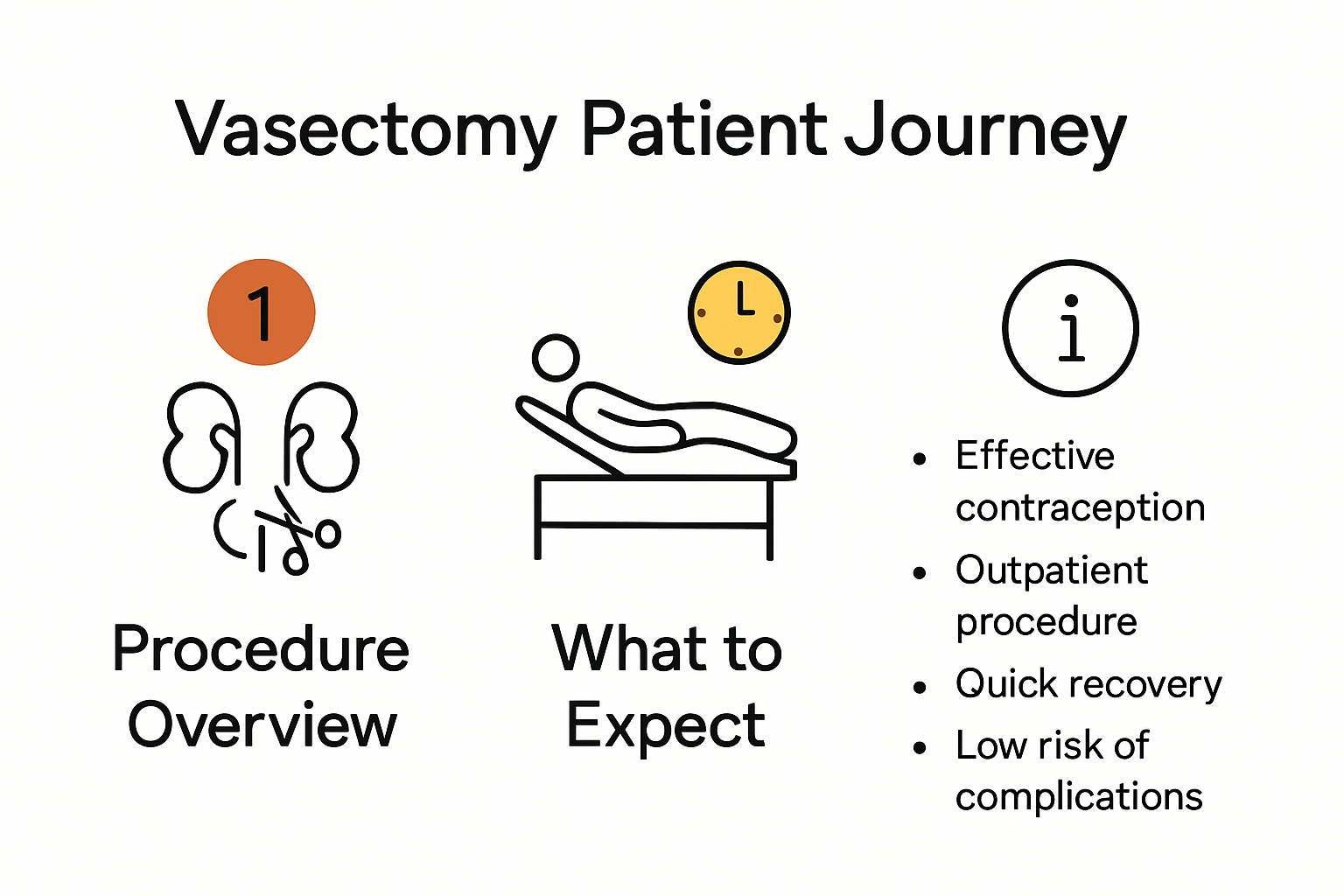A vasectomy offers a permanent solution for men who want reliable birth control, with over 500,000 procedures performed each year in the US alone. Most people assume the process is quick and hassle free, but the real story is far more involved. The twist is that even after the procedure, sterility is not immediate—most urologists recommend waiting at least 2 to 3 months or about 20 ejaculations before full effectiveness is confirmed. Here’s what every man considering vasectomy in 2025 truly needs to know.
Table of Contents
- Understanding The Vasectomy Procedure And What To Expect
- Essential Aftercare And Recovery Tips For Patients
- Vasectomy Confirmation And Follow-Up Testing Explained
- Family Planning: Fertility, Reversal, And Next Steps
Quick Summary
| Takeaway | Explanation |
|---|---|
| Vasectomy is a permanent contraception method | It effectively prevents sperm from reaching semen, offering men reliable reproductive control. |
| Post-procedure recovery is crucial | Patients should plan for adequate rest, wear supportive clothing, and avoid strenuous activities for optimal healing and to prevent complications. |
| Confirmation of sterility requires follow-up testing | It’s recommended to wait 2-3 months after the procedure or complete around 20 ejaculations before conducting a semen analysis to ensure complete sterility. |
| Vasectomy reversal is possible, but not guaranteed | Success rates for reversal vary and depend on several factors, so thoughtful consideration and counseling are advised before pursuing this option. |
| Sperm preservation options exist | Men seeking future fertility can consider sperm banking or surgical extraction as proactive strategies to ensure reproductive choices later on. |
Understanding the Vasectomy Procedure and What to Expect
A vasectomy represents a permanent male contraception solution that offers men a straightforward path to reproductive control. The procedure is designed to prevent sperm from reaching the semen during ejaculation, effectively making a man sterile. Understanding the details can help reduce anxiety and prepare patients for this significant medical decision.

The Surgical Approach
Modern vasectomy techniques have evolved to become minimally invasive and remarkably efficient. According to the American Urological Association, physicians typically perform two primary approaches: the traditional scalpel method and the no-scalpel technique. The no-scalpel vasectomy has gained significant popularity due to its reduced trauma and faster recovery time.
During the procedure, which usually takes 15 to 30 minutes, the urologist will access the vas deferens through a small puncture or incision in the scrotum. These tubes, responsible for transporting sperm from testicles, are then cut, sealed, or blocked to prevent sperm from mixing with semen. Local anesthesia ensures patient comfort, making the experience relatively pain-free.
Recovery and Immediate Expectations
Post-procedure recovery is typically straightforward. Medical experts from Mayo Clinic note that most men can return to light work within 48 to 72 hours. However, patients should plan for complete rest during the first two days and avoid strenuous activities for about a week.
Crucial recovery guidelines include:
- Pain Management: Use cold compresses and over-the-counter pain relievers
- Support: Wear snug athletic underwear to minimize scrotal movement
- Rest: Limit physical activity and sexual engagement for recommended period
Patients should understand that immediate sterility is not guaranteed. Residual sperm can remain in the reproductive system, requiring post-vasectomy semen analysis to confirm complete sterility. Most physicians recommend waiting 2-3 months or completing 20 ejaculations before considering the vasectomy fully effective.
Contrary to common misconceptions, a vasectomy does not impact sexual function, testosterone levels, or masculine characteristics. The procedure solely interrupts sperm transportation, leaving hormonal production and sexual performance entirely unchanged. This medical intervention offers a permanent, highly effective contraception method with minimal medical risks and significant long-term benefits for men seeking reproductive control.
Essential Aftercare and Recovery Tips for Patients
After a vasectomy, proper aftercare is crucial for ensuring optimal healing, minimizing complications, and promoting a smooth recovery. Understanding the right steps can significantly impact your post-procedure experience and overall comfort.
Immediate Post-Procedure Care
Experts from Cleveland Clinic recommend a strategic approach to the first few days of recovery. Rest becomes your primary focus. Patients should plan to lie down as much as possible during the initial 24 hours, reducing movement and potential strain on the surgical site. Cold compresses are an essential tool during this period, helping manage swelling and providing pain relief.
Wear supportive clothing is not just a suggestion but a critical recovery component. According to medical guidelines, tight-fitting underwear or an athletic supporter helps minimize scrotal movement, reducing discomfort and supporting the healing process. These garments provide compression that can significantly reduce post-surgical swelling and pain.
Activity Restrictions and Physical Management
Recovery is not a one-size-fits-all experience, but certain universal guidelines apply. Health professionals recommend gradually increasing activity while avoiding specific high-impact movements. For the first week, patients should strictly avoid:

- Heavy Lifting: Anything over 10 pounds can strain the surgical area
- Intense Exercise: No jogging, cycling, or strenuous workouts
- Sexual Activity: Abstain for approximately one week to prevent complications
Pain management is another crucial aspect of recovery. Over-the-counter pain medications like ibuprofen or acetaminophen can help control discomfort. Some men might experience mild bruising or tenderness, which typically resolves within a week. If severe pain persists or you notice signs of infection such as extreme swelling, fever, or unusual discharge, contact your healthcare provider immediately.
Long-Term Recovery and Fertility Confirmation
While physical healing occurs relatively quickly, fertility confirmation is a separate and critical process. Our guide on post-vasectomy testing highlights the importance of semen analysis to verify sterility. Most physicians recommend waiting 2-3 months or completing approximately 20 ejaculations before conducting a sperm count test.
Emotional recovery is equally important. Some men might experience temporary anxiety about the procedure’s impact on masculinity or sexual function. Rest assured, a vasectomy does not affect hormone production, sexual performance, or libido. It simply prevents sperm from entering the semen, offering a reliable contraception method.
Patients should maintain open communication with their healthcare provider, attend follow-up appointments, and listen to their body during the recovery process. By following these guidelines and being patient with your healing, you can ensure a smooth, comfortable recovery after your vasectomy.
Vasectomy Confirmation and Follow-Up Testing Explained
Vasectomy confirmation represents a critical step in the male sterilization process, ensuring the procedure’s effectiveness and preventing unintended pregnancies. Understanding the nuanced approach to post-vasectomy testing is essential for patients seeking reliable contraception.
The Science of Sperm Confirmation
The American Urological Association emphasizes that immediate sterility is not guaranteed after a vasectomy. Residual sperm can remain in the reproductive tract, necessitating a comprehensive follow-up testing protocol. Typically, physicians recommend waiting at least 12 weeks or completing approximately 20 ejaculations before conducting a semen analysis.
The post-vasectomy semen analysis (PVSA) involves examining a semen sample for the presence of sperm. Clinical guidelines from Cambridge University Hospitals indicate that clearance to stop using alternative contraception is typically granted after a single sample shows azoospermia (complete absence of sperm) or rare non-motile sperm.
Understanding Test Results and Risks
Patients should recognize that while vasectomy is highly effective, it is not 100% foolproof. Research indicates a residual pregnancy risk of approximately 1 in 2,000 cases. This underscores the importance of thorough follow-up testing and continued vigilance.
Key considerations for test results include:
- Azoospermia: Complete absence of sperm, indicating successful vasectomy
- Non-Motile Sperm: Rare, non-moving sperm may still require monitoring
- Continued Sperm Presence: Indicates need for additional testing or potential procedure revision
Learn more about interpreting your vasectomy test results, which can help you understand the nuanced details of your specific case.
Convenient Testing Options
Modern technology has transformed post-vasectomy testing, offering men convenient and discreet options. At-home semen analysis kits have emerged as a practical solution, allowing patients to complete fertility confirmation without multiple clinic visits. These kits provide a comprehensive analysis, checking sperm count, motility, and overall reproductive health.
Patients should maintain open communication with their healthcare provider throughout the confirmation process. While at-home testing offers convenience, professional medical interpretation remains crucial. Some men might require multiple tests to achieve confirmed sterility, and individual recovery can vary.
Ultimately, vasectomy confirmation is a precise medical process that demands patience and careful follow-up. By understanding the testing protocol, utilizing modern diagnostic tools, and working closely with healthcare professionals, men can confidently verify the success of their vasectomy and enjoy reliable contraception.
Family Planning: Fertility, Reversal, and Next Steps
While vasectomy is considered a permanent contraception method, life circumstances can change, prompting men to explore fertility restoration options. Understanding the complexities of vasectomy reversal and alternative reproductive strategies is crucial for comprehensive family planning.
Vasectomy Reversal Possibilities
The Mayo Clinic highlights that pregnancy rates after vasectomy reversal can range dramatically from 30% to over 90%. These outcomes depend on multiple critical factors including surgical technique, time elapsed since the original vasectomy, partner’s age, and the surgeon’s expertise.
Research from the University of North Carolina indicates approximately 5% of men who undergo vasectomy eventually seek reversal. The procedure involves reconnecting the vas deferens to restore sperm transportation, but success is not guaranteed. Surgeons typically recommend reversal within 10 years of the original vasectomy for optimal results.
Alternative Fertility Preservation Strategies
For men considering potential future fertility, sperm preservation emerges as a proactive strategy. Options include:
- Sperm Banking: Collecting and freezing sperm before vasectomy
- Surgical Sperm Extraction: Retrieving sperm directly from testicles if reversal is unsuccessful
- In Vitro Fertilization: Using extracted sperm for assisted reproductive techniques
Explore comprehensive details about fertility testing and preservation to understand your specific reproductive options.
Emotional and Psychological Considerations
The decision to pursue fertility restoration involves significant emotional complexity. Research from reproductive health experts suggests success rates for sperm return range from 60% to 95%, but pregnancy remains possible in only about 50% of cases. These statistics underscore the importance of careful consideration and professional counseling.
Couples should engage in open, honest discussions about their long-term family planning goals. Factors such as age, financial resources, and personal preferences play crucial roles in determining the most appropriate path forward. While vasectomy reversal and fertility restoration technologies continue to advance, they are not guaranteed solutions.
Professional medical consultation remains the most reliable approach. Urologists specializing in reproductive medicine can provide personalized assessments, helping individuals navigate the intricate landscape of fertility restoration. By maintaining realistic expectations and exploring comprehensive options, men can make informed decisions that align with their family planning objectives.
Frequently Asked Questions
What is a vasectomy?
A vasectomy is a surgical procedure that provides permanent contraception for men by preventing sperm from mixing with semen during ejaculation.
How long does it take to recover from a vasectomy?
Most men can return to light work within 48 to 72 hours after the procedure, but full recovery may take about one week, with restrictions on strenuous activities and sexual engagement during that period.
When will I know if my vasectomy was successful?
It is recommended to wait 2 to 3 months or approximately 20 ejaculations before conducting a semen analysis to confirm sterility.
Can a vasectomy be reversed?
Yes, a vasectomy can be reversed, but success rates vary significantly depending on multiple factors. It’s essential to consult with a healthcare provider for personalized advice regarding reversal options.
Confirm Your Vasectomy Success With Confidence—The Easiest Next Step
You have learned how crucial post-vasectomy semen analysis (PVSA) is to ensure your procedure achieved its goal. Many men feel anxiety or uncertainty about returning to the clinic for follow-up testing. The good news is that you do not have to trade your comfort for accuracy. Getting this last important step done should be quick, private, and reliable.





